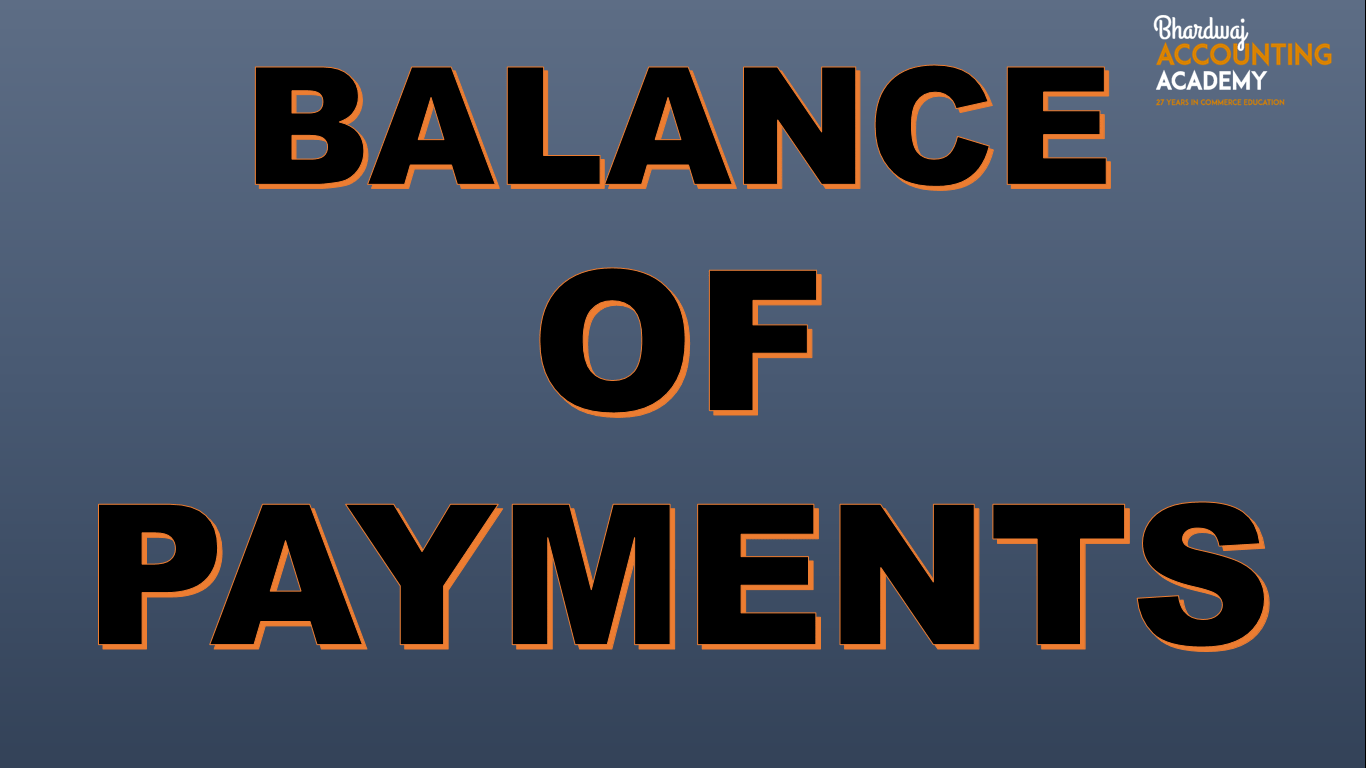Table of Contents
BALANCE OF PAYMENTS
BALANCE OF PAYMENTS?
The balance of payments is a systematic record of all economic transactions between the residents of a country and the rest of the world during a financial year.
In other words, The balance of payments is a summary record of all international economic transactions of a resident country with the rest of the world during a given period of time.
Or
The balance of payments of a country is a systematic record of all economic transactions between the residents of the reporting country and the residents of foreign countries during a given period of time.
In the Words of Benham” Balance of payments of a country is a record of the monetary transactions over a period with the rest of the world.
Economic transactions?
Economic transactions refer to transactions that involve the transfer of ownership of goods, services, money, and assets.
* VISIBLE ITEMS *
Visible Items include all types of merchandise (Physical Goods)which are imported and exported. They are made of some material and can be seen, touched, and measured.
* INVISIBLE ITEMS *
Invisible items of trade refer to all types of services like shipping, banking, insurance, travel, etc., which are given and received. These are called invisible items as they cannot be seen, felt, touched, or measured.
* CAPITAL TRANSFERS *
Capital transfers include the capital receipts & capital expenditure of a resident country.
* UNILATERAL TRANSFERS *
Unilateral transfers include gifts, personal remittances, and other one-way transactions.
FEATURES OF BALANCE OF PAYMENTS
(i) Balance of payments is a systematic record of all economic transactions between one country and the rest of the world.
(ii) It includes all transactions, visible as well as invisible.
(iii) It relates to a period of time.
(iv) Generally, the balance of payments is an annual accounting statement.
(v) It shows the country’s position in the world.
(vi) It must always balance.
(vii) Balance of payments adopts the double-entry system of bookkeeping.
(viii) It includes all economic transactions both on the current account and capital account.
COMPONENTS OF BALANCE OF PAYMENTS

CURRENT ACCOUNT
Current account refers to an account which records all the transactions relating to export and import of goods and services and unilateral transfers during a given period of time. The main components of current account are –
(1) EXPORT AND IMPORT OF GOODS (Visible Items) – The balance of export and import of goods is called the balance of visible trade. Payment for import of good is written on the negative side and receipt from export is shown on positive side.
(2) EXPORT AND IMPORT OF SERVICES (Invisible Trade) – The balance of exports and imports of services is called the balance invisible trade. Example – Shipping, Banking, Insurance etc. Payments for these services are written on the negative side and receipt on positive side.
(3) UNILATERAL TRANSER TO AND FROM ABROAD – Unilateral transfers is receipts which residents of a country make without getting anything in return eg. Gifts, donation, personal remittances etc.
(4) INCOME RECIEPT AND PAYMENT TO AND FROM ABROAD – It includes income in the form of interest, rent and profits. The net balance of visible trade, invisible trade and of unilateral transfers is the balance on current account. Current Account shows the Net Income.
CAPITAL ACCOUNT
Capital account of balance of payments records all those international transactions, between the residents of the domestic country and rest of the world, which cause a change in the assets or or liabilities of the residents of the country or its government. Various forms of capital account transactions :-
(1) PRIVATE TRANSACTIONS – There are transactions that affect the liabilities and assets of individuals.
(2) OFFICIAL TRANSACTIONS – Transactions affecting assets and liabilities by the govt. and its agencies.
(3) PORTFOLIO INVESTMENT (FII) – It is the acquisition of an asset that does not give the purchaser control over the asset.
(4) DIRECT INVESTMENT (FDI) – It is the act of purchasing an asset and at the same time acquiring control of it.
(5) BANKING INFLOW – Inflow of hot money seeking the highest rate of return as NRI deposits.
(6) OFFICIAL RESERVE TRANSACTION – It includes change in a countries gold reserves, foreign exchange reserves, foreign securities and SDRs with IMF. The net value of the balance of direct and portfolio investment is called the balanced on Capital Account
BALANCE ON CURRENT ACCOUNT
The net value of credit and debit balance is the balance on current account.
1. Surplus in current account arises when credit items are more than debit items. It indicates net inflow of foreign exchange.
2. Deficit in current account arises when debit items are more than credit items. It indicates net outflow of foreign exchange.
BALANCE ON CAPITAL ACCOUNT
The net value of credit and debit balance is the balance on capital account.
1. Surplus in capital account arises when credit items are more than debit items. It indicates net inflow of capital.
2. Deficit in capital account arises when debit items are more than credit items. It indicates net outflow of capital.
